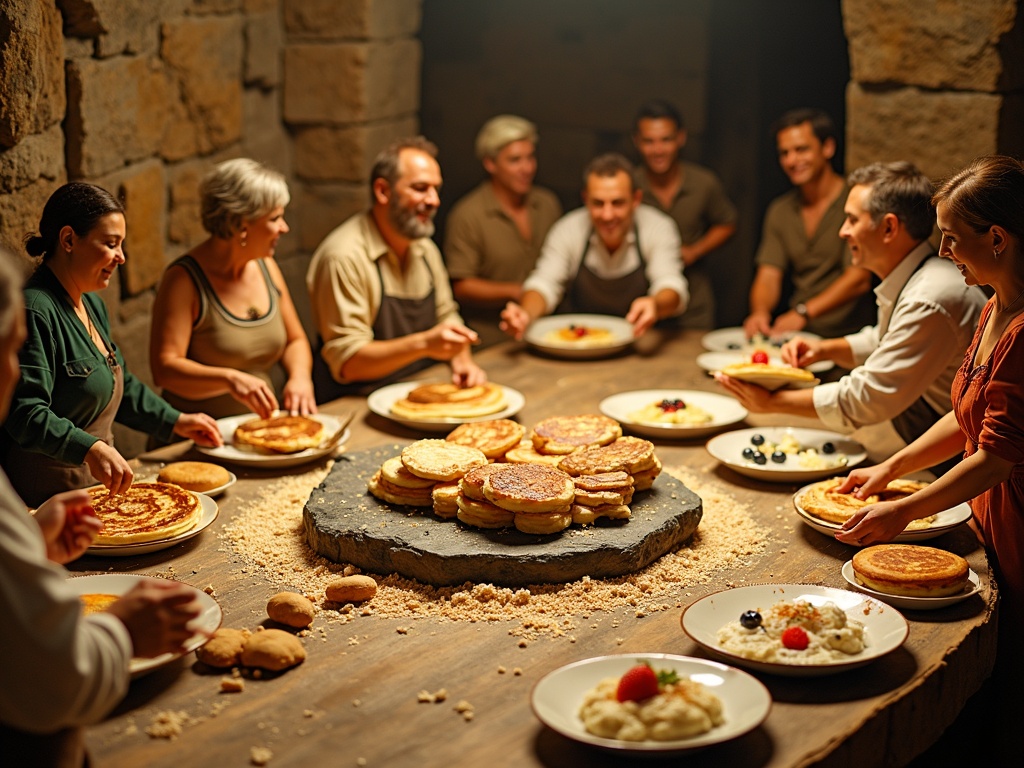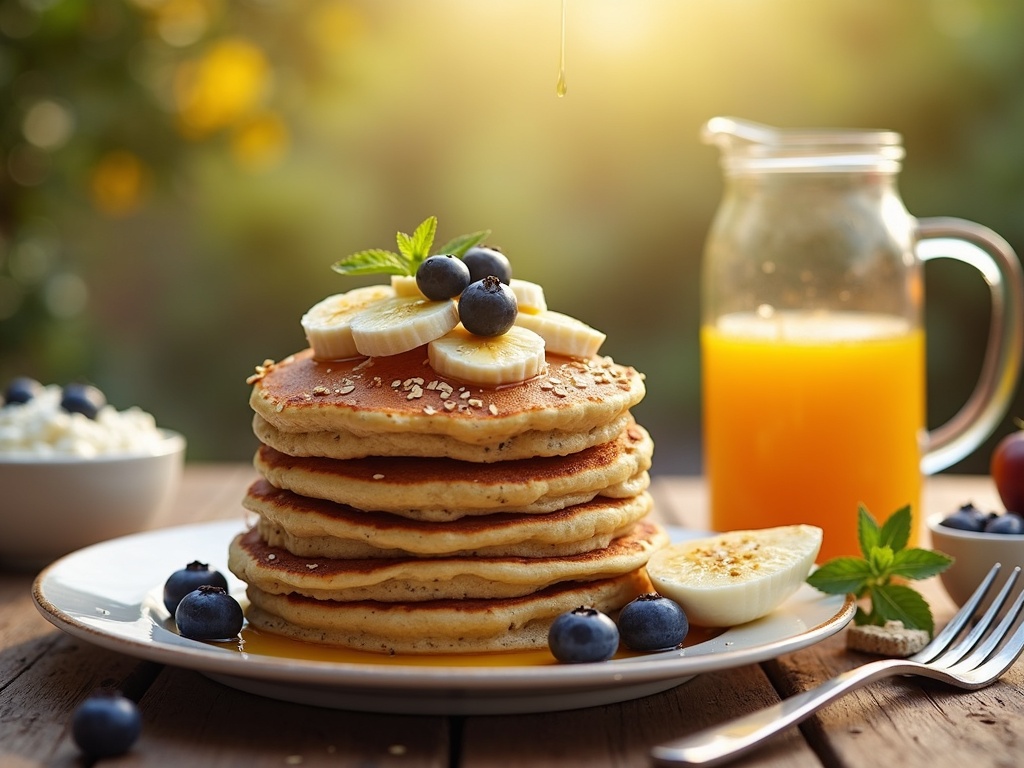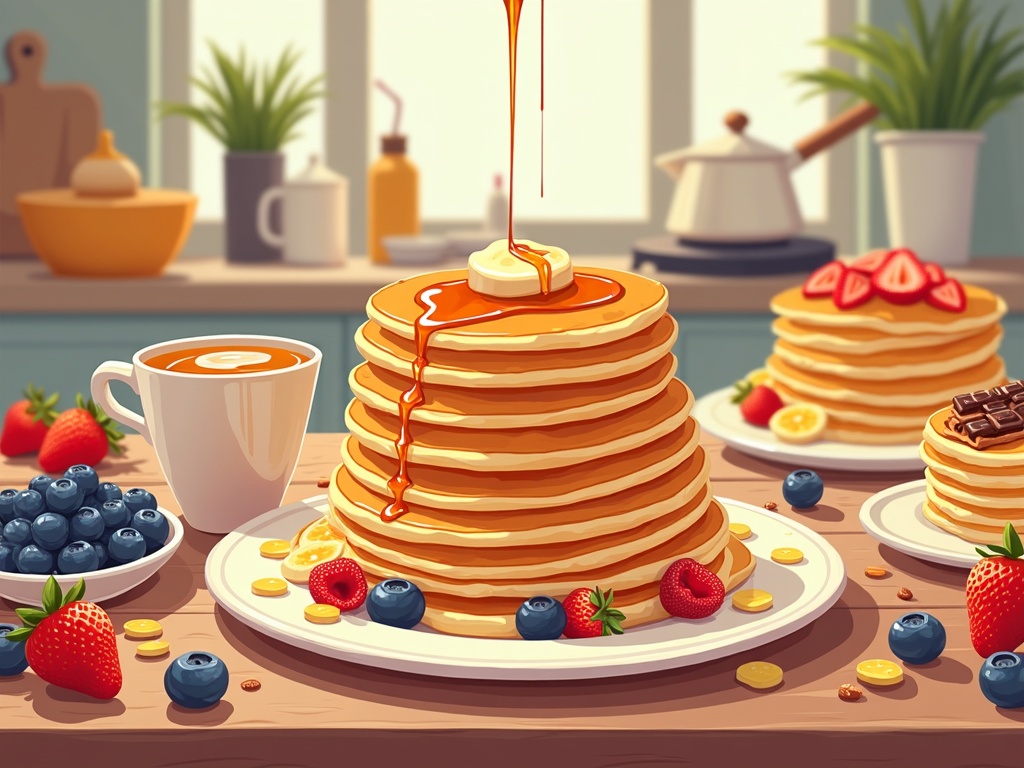Pancakes have evolved from an ancient Stone Age creation to a beloved breakfast staple enjoyed in countless variations across the globe. These versatile discs of cooked batter appear in different forms worldwide, from France’s thin crêpes to Japan’s fluffy soufflé pancakes, while maintaining their basic cooking method and cultural significance throughout human history.
Find In This Article
Key Takeaways
- Pancakes date back to 9000 BC during the Stone Age, making them one of humanity’s oldest prepared foods with archaeological evidence of early versions made from ground grains and water.
- Different cultures have developed unique pancake varieties, including French crêpes, Russian blinis, Indian dosas, and Japanese soufflé pancakes, each with distinctive characteristics.
- For perfect pancakes, cooking technique matters: use a 375°F griddle, flip only once when bubbles form, and avoid overcrowding the pan.
- While not typically considered health food, pancakes can be nutritionally improved by using whole grains, adding fruits, and choosing healthier toppings than traditional syrup.
- Pancakes play a significant role in celebrations worldwide, particularly Shrove Tuesday (Pancake Day), and have become central to community gatherings and family traditions.
From Ancient Food to Modern Breakfast Star
I’ve always been fascinated by how the humble pancake has stood the test of time. These delicious discs of cooked batter aren’t just a modern breakfast favorite – they’re one of humanity’s oldest prepared foods. Archaeological evidence suggests that pancakes have been around since 9000 BC during the Stone Age, when our ancestors created simple versions using ground grains and water cooked on hot stones.
A Global Culinary Journey
The first written mention of the term “pancake” didn’t appear until the 15th century in English literature, but variations of this versatile food had already spread across continents and cultures:
- France gave us the elegant, paper-thin crêpes that can be filled with sweet or savory ingredients.
- Russia contributed blinis, traditionally topped with sour cream and caviar.
- India developed dosas, fermented rice and lentil pancakes with a distinctive tangy flavor.
- Japan created fluffy soufflé pancakes that have recently taken social media by storm.
Pancakes hold significant cultural importance in numerous traditions worldwide. In many Christian communities, Shrove Tuesday (also known as Pancake Day) marks the day before Lent begins – a time to use up rich ingredients like eggs and milk before the fasting period. I’ve found that quick pancake recipes are especially popular during these celebrations.
What started as a simple mixture of ground ancient grains and water has evolved into countless variations. Modern ube mochi pancakes showcase how traditional techniques have merged with innovative ingredients. The basic cooking method, however, remains remarkably similar to what our ancestors practiced thousands of years ago.
Pancakes’ versatility has cemented their place as a breakfast staple across the globe. Their adaptability to both sweet and savory flavor profiles makes them suitable for any meal. The relatively simple preparation has helped pancakes remain relevant throughout human history – from prehistoric kitchens to modern brunch spots.
The enduring popularity of pancakes speaks to their perfect balance of simplicity and satisfaction. Few foods can claim such a long and diverse cultural heritage while remaining essentially unchanged in their basic form. This ancient food continues to bring people together around the table, just as it has done for thousands of years.

Perfect Your Pancake-Making Technique
Making fluffy, golden pancakes isn’t rocket science, but there are some key techniques that separate average pancakes from extraordinary ones. I’ve spent years perfecting my method, and I’m excited to share these tips with you.
The Foolproof Basic Recipe
I start with a simple yet reliable pancake batter that never disappoints. Mix together 1 cup flour, 2 tablespoons sugar, 1 tablespoon baking powder, and ½ teaspoon salt in a bowl. In a separate container, whisk 1 cup milk, 1 egg, and 2 tablespoons melted butter. Then combine the wet and dry ingredients until just mixed – those small lumps are actually good for texture!
Temperature control makes a huge difference in pancake success. I heat my griddle to precisely 375°F (190°C) before adding any batter. Too hot and you’ll burn the outside while leaving the inside raw; too cool and you’ll end up with pale, soggy pancakes.
The timing for flipping pancakes is crucial. I pour about ¼ cup of batter per pancake and wait patiently until bubbles form on the surface and the edges look set – usually about 2-3 minutes. Then I flip just once and cook for another 1-2 minutes. This single flip is important! Many home cooks make the mistake of flipping multiple times, which deflates the pancakes and ruins their fluffy texture.
Another common mistake is overcrowding the pan. I make sure to leave plenty of space between pancakes for easy flipping and even cooking.
For delicious variations, I sometimes add blueberries, sliced bananas, or chocolate chips to the cooking pancakes. For the best results, I sprinkle these toppings directly onto the batter right after pouring it onto the griddle, before the surface sets.
For more adventurous flavor combinations, try my ube mochi pancakes which bring a delightful purple twist to your breakfast table. If you’re in a rush, check out my quick pancake recipe that can be whipped up in minutes.
These techniques work whether you’re making a simple weekday breakfast or preparing a special breakfast spread for guests. With practice, you’ll develop an intuition for pancake perfection that will make you the breakfast hero in your household.
What Makes Each Style Special
I’ve discovered that pancakes are an incredibly versatile food, with countless variations across different cultures. Each style brings its own unique characteristics to the breakfast table, making the world of pancakes a delicious playground for culinary exploration.
Distinctive Pancake Varieties Around the World
American-style pancakes are what many people think of first – thick, gloriously fluffy discs that stack beautifully on a plate. Their secret? Baking powder gives them that characteristic rise and airy texture. I find these perfect for soaking up maple syrup or when I’m craving a quick pancake recipe that delivers comfort food satisfaction.
French crepes take a completely different approach. These paper-thin pancakes contain no leavening agent, resulting in delicate, flexible rounds that can be folded or rolled around fillings. The batter is much thinner than American varieties, allowing it to spread into those signature large, thin circles when poured onto the hot pan.
Russian blinis stand out with their distinctive flavor profile. These pancakes use yeast as a leavening agent rather than baking powder, creating a slightly fermented taste. What truly sets them apart is the use of buckwheat flour, which gives them a nutty, earthy flavor and darker color. Traditionally topped with sour cream and caviar, they demonstrate how pancakes can move easily between sweet and savory territories.
Japanese soufflé pancakes have gained popularity in recent years, and for good reason. Their incredibly airy, jiggly texture comes from folding whipped egg whites into the batter. This technique, borrowed from soufflé-making, creates pancakes that are almost cloud-like in their lightness. These ube mochi pancakes offer a delightful Asian twist on this Japanese style.
What makes each style truly special often comes down to the toppings and serving traditions. Regional preferences highlight the cultural significance of pancakes:
- Italian pancake enthusiasts often reach for Nutella, creating a chocolate-hazelnut treat that satisfies sweet cravings.
- Scandinavian countries favor fruit preserves, particularly lingonberry or cloudberry, adding bright acidity to balance the richness.
- Throughout Asia, savory fillings dominate, with options like scallions, kimchi, seafood, or minced meat transforming pancakes into substantial meals.
- Middle Eastern pancake variations feature honey, date syrup, or nuts for sweet versions, or cheese and herbs for savory options.
The beauty of pancakes lies in their adaptability. While traditional methods have developed over generations, there’s always room for creative interpretation. I’ve found that understanding these different styles opens up new breakfast possibilities, whether I’m cooking for a special occasion or just looking to upgrade my morning routine.
Each pancake tradition tells a story about its culture of origin – from the ingredients available to the preferred flavor profiles. By exploring these various styles, I’ve gained appreciation for how a simple combination of flour, liquid, and heat can transform into so many distinctive and delicious creations.
The Health Factor
I’ve often considered pancakes a treat rather than a health food, but looking at the nutritional facts, they aren’t as indulgent as you might think. A standard serving of three medium pancakes contains approximately 350 calories, making them comparable to other breakfast options. They also provide about 10 grams of protein, which helps keep you satisfied throughout the morning.
One aspect worth noting is the fiber content. Standard pancakes deliver around 4 grams of fiber per serving, which contributes to your daily recommended intake. For those interested in boosting this number, switching to whole grain versions can significantly impact nutritional value.
Nutritional Improvements Through Ingredients
Whole grain pancakes stand out as a nutritional powerhouse compared to their refined flour counterparts. They contain four times more fiber, which supports digestive health and creates a longer-lasting feeling of fullness. I’ve found these simple ingredient swaps can transform pancakes from occasional treats to regular breakfast options:
- Substitute refined flour with whole wheat or multigrain alternatives
- Add ground flaxseed for omega-3 fatty acids
- Mix in fresh fruits like bananas or blueberries for added nutrients
- Incorporate oats for additional fiber and texture
Toppings dramatically affect the nutritional profile of pancakes. Traditional maple syrup adds approximately 52 calories and 13.4 grams of sugar per tablespoon. While delicious, I recommend using it sparingly or exploring alternatives like fresh fruit, a light drizzle of honey, or Greek yogurt.
For a healthy spin on traditional recipes, you might enjoy trying ube mochi pancakes which incorporate purple yam for added nutrients and a beautiful color. If you’re short on time but still want a nutritious option, a quick pancake recipe can be modified with healthier ingredients without sacrificing convenience.
Balance is key when enjoying pancakes as part of a healthy diet. Pairing them with protein-rich sides like eggs or yogurt creates a more complete breakfast that provides sustained energy. By making thoughtful choices about ingredients and toppings, pancakes can be both delicious and reasonably nutritious.

Celebrate with Pancakes
Pancakes aren’t just for breakfast—they’ve become central to celebrations around the world. I’ve found that these versatile treats bring people together in surprisingly festive ways, creating traditions that span generations and cultures.
Shrove Tuesday and Global Traditions
Shrove Tuesday, also known as Pancake Day in many countries, marks the day before Lent begins. This centuries-old tradition started as a practical way to use up eggs, milk, and sugar before the fasting period. In the UK, families gather to flip pancakes, often turning it into a friendly competition. Meanwhile, in France, they celebrate with crêpes on “Mardi Gras” (Fat Tuesday), often tossing the first one with a coin in hand—tradition says if you catch it, you’ll have prosperity for the year.
Across the Atlantic, countries like Brazil embrace similar customs but with their own local twists. Swedish families enjoy “semla” pancakes stuffed with almond paste and whipped cream, showing how each culture has adapted pancake celebrations to match their tastes.
Modern Pancake Celebrations
National Pancake Day in the United States falls on September 26th, though you’ll find pancake celebrations scattered throughout the year. Many restaurants offer free pancakes, while communities organize events centered around these beloved treats. I’ve participated in breakfast festivals where pancake-eating contests draw surprising crowds.
Community pancake races have become a highlight of these celebrations. Participants run while flipping pancakes in pans—a tradition dating back to 1445 in Olney, England. Today, these races raise money for charities while bringing neighbors together. The International Pancake Day race between Liberal, Kansas, and Olney, England has been running since 1950, creating a friendly transatlantic rivalry.
Modern festivities have evolved to focus on family togetherness. Parents and children mix batter, choose toppings, and create memories around the kitchen table. Many families have developed their own pancake traditions, from quick pancake recipes for busy weekdays to elaborate ube mochi pancakes for special occasions.
Schools and community centers host pancake breakfasts to fund projects, turning a simple meal into an opportunity for neighborhood bonding. I’ve seen these events grow from small gatherings to major community highlights, proving that something as simple as a pancake can bring people together across generations and backgrounds.
Pancake celebrations remind us that food traditions aren’t just about eating—they’re about connecting with our heritage, building community, and creating lasting memories with those we love.
Sources:
A Brief History of Pancakes – National Geographic
Nutritional Analysis of Pancakes – USDA Food Data Central
Pancake Recipes & Cooking Tips – American Culinary Federation
Exploring Global Pancake Variations – Food Network
Pancake Day Traditions Worldwide – BBC Good Food

